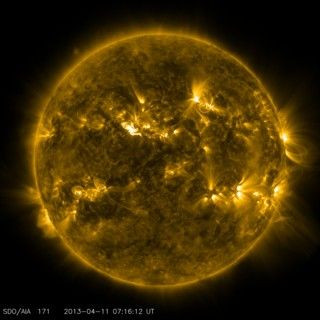Solar Flares Linked to Increased Risk of Cancer

Violent storms on the star's surface and the resulting coronal mass ejections send radiation and solar material toward Earth. The energized particles exploding from such solar flares arrive in only eight minutes. Generally, the Earth's atmosphere and magnetic field shield most people from potentially harmful solar and cosmic radiation, though astronauts or people on board an airplane risk exposure to intense radiation. Short-term damage could include skin irritation. Long-term consequences might include an increased risk of developing skin cancer.
An increasing number of international airlines fly routes over or quite near the poles; these are far shorter routes than following latitude lines, plus they save fuel. Yet, there is increased danger in that these flight paths move planes and their passengers through the thinner layers of Earth's magnetosphere. In studies of how much radiation pilots and airline passengers are exposed to, scientists have never accounted for solar flares and the powerful bursts of radiation they eject.
Solar flares push out waves of light all across the spectrum, including light unseen -- radiation in the form of x-rays and gamma rays that are dangerous to humans. The largest type of solar flare, known as X-class, has the most significant effect on Earth. They can cause long-lasting radiation storms in the upper atmosphere, and trigger radio blackouts. Medium-size M-class flares can cause brief radio blackouts in the polar regions and the occasional minor radiation storms. C-class flares have few noticeable consequences. Since X-rays and gamma rays fail to penetrate the atmosphere, only space-based telescopes can detect their signatures.
Scientists have been using NASA's Solar Dynamics Observatory (SDO) to learn more about our closest star. Images captured by SDO have regularly caught solar flares and coronal mass ejections in the act, types of space weather that can send radiation and solar material toward Earth and interfere with satellites in space. Despite their size and high energy, solar flares are almost never visible optically since the surrounding photosphere -- where the sun's light originates --- and its emissions overshadow even explosive phenomena from the sun.
Since it first provided images of the sun in the spring of 2010, SDO has had coverage of the sun's rise toward solar maximum, the peak of solar activity in its regular 11-year cycle. The solar cycle is defined by an increasing and then decreasing number of sunspots. As it reaches the close of a cycle, new sunspots appear near the equator, while a new cycle produces sunspots in higher latitudes. Because the cycles overlap and sunspots from the previous cycle may develop even after sunspots from the new cycle appear, solar scientists have a difficult time saying exactly when one cycle ends and the next begins.
With the aid of SDO, scientists are hoping to understand what causes the giant, explosive flares in order to improve our ability to predict this space weather.
Published by Medicaldaily.com



























